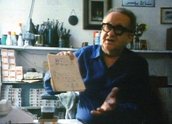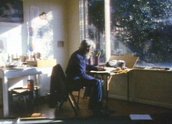


Painting the Town: A Film About Yosl Bergner (1987)
Synopsis
Painting the Town is a portrait of artist Yosl Bergner in the context of the Melbourne artistic milieu of the 1930s and 1940s. It tells the story of his short but significant period in Australia, his life in Israel, and his return to Melbourne in 1985 to open a major exhibition of his work at the National Gallery of Victoria. Although Bergner was only in his late teens when he arrived, his influence on the Melbourne art scene was profound. He befriended many of the local artists, encouraging them to go beyond their traditional styles and incorporate social commentary on the human condition into their work. He was one of the first contemporary artists to depict the plight of urban Aboriginal people and to draw parallels between their dispossession and that of the Jews in eastern Europe. Painting the Town tells an important and entertaining story by drawing on observational footage, archive material, photos and notable paintings from the period. It also features interviews with Bergner, his sister Ruth Bergner, and artist Albert Tucker.
Curator’s notes
Bergner, a Polish Jew, came to Australia in 1937 as a 17-year-old to join his sister and father who had fled anti-Semitism in Europe. Bergner had grown up in Warsaw where he took painting lessons and was inspired by European modernism. In Melbourne, he sought out and befriended painters like Albert Tucker, Jim Wigley, Joy Hester, Arthur Boyd, Sidney Nolan, John Perceval and Danila Vassilieff. He continued his studies at the National Art School in Melbourne and joined the new Contemporary Art Society.
In the film, Albert Tucker states that Bergner 'was already a fully fledged painter with a fully developed style unheard of for any Australians of the same age, because we simply didn’t have the starting point’. His early exposure to cubism and expressionism helped turn the Melbourne art establishment on its ear. In his paintings, Bergner used his memories of Warsaw and observations and experiences of Australia. His depiction of refugees, ghettos and the destruction of Europe are exceptional but most extraordinary are those of urban Australian Aboriginal people.
Bergner and many of his artist friends became influential figures in the social realism movement of the 1940s. They were affected by the hardship caused by the Depression and dissatisfied with a system that was doing little to remedy the situation. At the time, a constant stream of refugees brought distressing news of the war in Europe. Bergner and his fellow artists were determined to paint the life of cities and the ordinary people around them, which brought them into opposition with both the art and political establishments of the day. They were painters with a message who wanted to deal with the injustices of the world in their work.
The paintings used in the film’s montages are mesmerising and beautifully photographed. Painting the Town was shot on 16mm film by John Whitteron. It took 10 days just to capture the paintings. To avoid filming the reflections of the glass covering the art, the crew had to cross light the painting from each side and have complete darkness behind the camera. Strips of cardboard, covered with black velvet and clamped around the painting, disguised the ornate frames (with today’s digital technology, the frames could be easily matted out in post-production).
Before directing Painting the Town, Trevor Graham had made one other film, Red Matildas (1984), with Sharon Connolly. Red Matildas explored the social and political conditions in Australia during the Great Depression through the lives of three women. For his next film, Graham wanted to examine the art of this period and Bergner’s 1985 exhibition at the National Gallery of Victoria gave him the perfect opportunity.
As a subject, Bergner is cheeky and self-deprecating and relates his story with wit and compassion. He is interviewed in his studio in Tel Aviv and in Melbourne’s markets and cafés. Extensive archival footage is beautifully integrated with interviews, paintings and observational footage. The soundtrack features Jewish klezmer music and jazz and successfully evokes the period.
Painting the Town was one of the first documentaries to be commissioned by the ABC under a pre-sale agreement rather than purchased after completion. It screened at the Melbourne International Film Festival, Italy’s Festival dei Popoli, the Jewish Film Festival, Jerusalem International Film Festival, St Kilda Film Festival and Frames Film Festival. It had theatrical releases in Melbourne and Perth and won Best Documentary at the 1987 AFI Awards.
- Overview
- Curator’s notes
- Video 3 clips

- Principal credits
- Find a copy
- Make a comment
- Map
- Add your review



